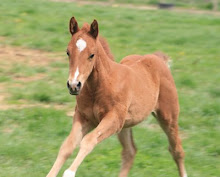I do not know if I buy this, but here is a recent study
Researchers: Mare's Condition Appears to Impact Sex of Foal
by: Liz Brown October 18 2008, Article # 12917
A recent study of wild horses in New Zealand has found that broodmares that are healthiest at the time of conception are more likely to have colts.
The study, conducted by researchers Elissa Cameron, MSc, PhD, and Wayne Linklater, PhD, found a striking correlation between the change in a mare's condition and the sex of her foal. In mares that were gaining weight at the time of conception, 80% had a colt, while only 3% who were losing weight gave birth to a colt. The reason for this, the researchers hypothesize, is that strong mares will produce strong foals, and a strong colt would be able to spread the mare's bloodlines more than a strong filly.
Cameron said she believes it is the change in the mother's condition that might determine the sex of the foal. She hopes one day this can be applied to the breeding management of domestic horses, but at present, the mechanism that might be causing this relationship isn't understood.
"It appears that glucose may play a role as we manipulated glucose levels in mice and got a shift in sex ratio," Cameron said. "However the relationship is complicated, especially if it is driven by glucose levels since glucose is pretty well regulated by insulin."
**********************
This one makes more sense to me
Foal's Playfulness a Reflection of Gender, Mare's Condition
by: Liz Brown October 16 2008, Article # 12911
The body condition of a mare and the sex of her foal will determine how much the foal plays, according to a new study by researchers at the Mammal Research Institute at the University of Pretoria in South Africa.
The group, led by Elissa Cameron, MSc, PhD, observed the play habits of foals in bands of feral horses on the central north island of New Zealand. They observed the body condition of the mares before the foal's birth, during the first four months of the foal's life, and when the foal reached its first birthday.
They found that colts played significantly more when their mothers were in good body condition, but fillies with mothers in poor condition played more than colts with mothers in poor condition. The mothers that lost the most body condition from nursing in the first three months had the foals that played the most. They postulated that the increased nutritional investment made the foals more likely to play.
In earlier research, Cameron had shown that mothers in good condition spent more time close to their sons, ended fewer nursing sessions, and were more tolerant of boisterous play. Conversely, mothers in poor condition acted the same way towards their daughters.
As play is thought to improve fighting and socialization skills, the researchers believe the foals with stronger skills would be the most likely to be successful and pass on their mother's genes. A mother in good condition would spread her genes more successfully through a strong son who might breed many mares, while a mother in poor condition would have more chance of passing on her genes through a filly that would likely breed at least once, rather than a weak male that might not breed at all.
According to Cameron, it is difficult to say if horse owners can apply these findings to their own programs.
"One thing it may influence, if foals are kept at pasture, is physical development," she said. Physical activity, including play, has been shown to influence bone and muscle growth and result in better tendon strength and flexibility.
I definitely believe that last paragraph, which is why our babies are raised outside with free room to roam as they see fit. They are kept in big pastures with other mamas and foals, so they can interact, and this stimulates them to self-exercise more.
Tuesday, October 21, 2008
Foal Gender Study
Subscribe to:
Post Comments (Atom)





















7 comments:
I saw that study and I don't buy it because the male's sperm decides whether a colt or filly. If they can prove the mare's uterus environment favors male sperm over female sperm, then I would like to see that study.
I agree--but they are missing that link in this study for sure. Especially because the mare's condition is an ever changing status, and sex of the foal is not.
Just dumb
Seems to me that whom ever did the study has no formal training in equine reproduction, because everyone knows the sperm are the ultimate deciders...
LOL-I read that and had to scratch my head. They seemed to be saying a whole lot of nuthin'.
Some studs have the propensity to produce more colts and some more fillies(in general), but it gets interesting when you notice that some mares are prone to producing more fillies or more colts, irregardless of what stud they are bred to. Do you think that reproduction trait comes from the sire of the mare? Of course then questions like that lead you into wondering why some studs reproduce exceptional colts and average fillies or visa versa.
I think there is probably something to the nature of the mare's uterus that makes it more hospitable to boy or girl sperm
I agree that it seems like this is much ado about nothing, and I suspect that the article is just poorly written--perhaps with a litle more info, we would see why they think this is viable, instead of just looking elementary
I think Paige is right - if it's actually true, when the mare is gaining weight there's something slightly different about her hormones that makes something in her uterus slightly more hospitable to the Y sperm. Maybe the mucus is thicker and the slightly lighter weight Y sperm have an easier time getting to the prize at the end?
But I kinda doubt this study too. I mean, Thoroughbred people know more about breeding and spend more money and keep better records than anybody else, and you'd think they'd have noticed this. Maybe they just never analyzed the data. Shrug!
That is interesting. I know my mare has only ever had colts. I have had two colts out of her and before I bought her I saw two of her foals all grown up, both geldings.
I do know that the male determines the sex of the foal. But one thing I did learn that totally doesn't have anything to do with this at all, but my vet said that he could tell if the foal was a colt of a filly. At about 120 days. He could tell. Neat huh!!
Post a Comment